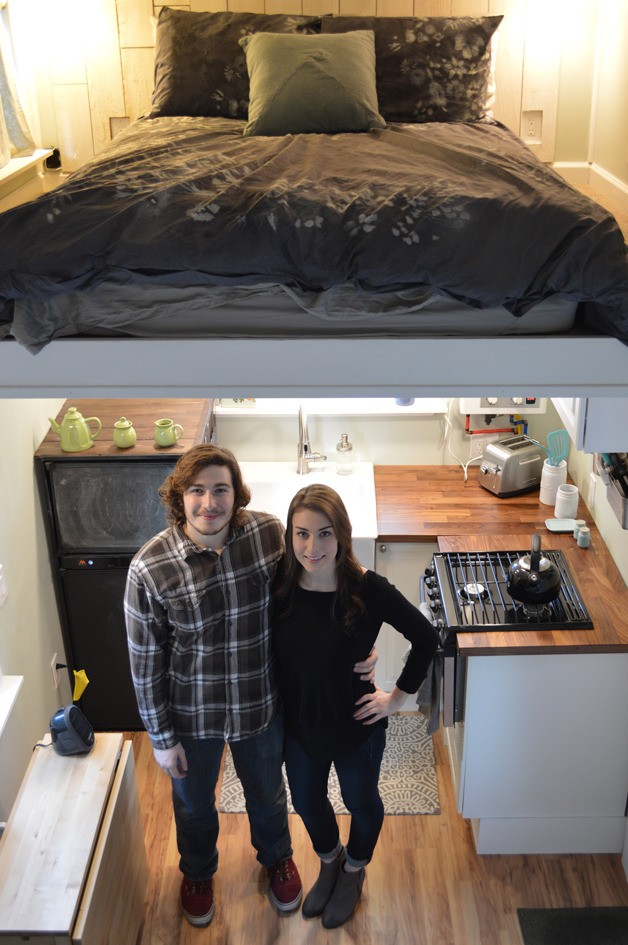 Trash soiled the floor, diapers caught runaway drippings from the skylight and the rats had left behind their own housewarming gift in the form of droppings.
Trash soiled the floor, diapers caught runaway drippings from the skylight and the rats had left behind their own housewarming gift in the form of droppings.
A musty smell infected the air with base notes of urine, possibly from the old toilet stashed in the corner, or the critters that burrowed in the rusted-out trailer.
“It was kind of a dump,” Nick Hinton recalled. “The whole back half was gone. They were saying homeless people were living in there.”
But Hinton and his girlfriend, Nora Phillips, weren’t afraid of the mess. All they wanted was the metal frame, and it came free, courtesy of Freecycle.
Phillips was the one who decided they should build a tiny house, three months before. At 20 and 22, they were ready to move out of their childhood homes, but their $1,000-a-month budget didn’t really cut it on Bainbridge.
A tiny house seemed to be the affordable option.
“We could build our tiny house for 12 to 15 [grand] and live in it, for maybe five years,” Hinton explained. “And we weren’t wasting a bunch of money on renting.”
They hauled the trailer to Phillips’ parents’ house and tore it apart — roofing, flooring, sewage tank, walls — scrapping away all the muck, except for the gray water tank for the shower, which was still usable.
And then they began again, building the structure anew according to plans drawn up by Hinton, who had just completed a Technical Design ATA at Olympic College.
The drawing was the easy part; the construction “took forever,” Phillips said.
Both Hinton and Phillips were working full-time, so the trailer became their after-hours baby. It didn’t cry in the middle of the night, but for two years it sucked up their weekends.
Phillips’ stepfather, a journeyman electrician, taught the couple to weld and assisted with the wiring. Free advice also came by way of Hinton’s colleagues at Home Depot.
And, for everything else, the millenials turned to Google.
Hinton watched a lot of YouTube videos about plumbing.
“I had no idea what to do,” he said. “I was looking around at copper tubing versus PEX tubing. YouTube helped a lot.”
But, as with any new project, mistakes were a given.
“We did the roof in the rainy season,” Phillips said. “In the summer, I was like, ‘Please dry out!”
Later, they discovered it was rotting. The original structure lacked an overhang, causing water to seep under the materials. They had to do it over and when they did, they added gutters.
Then one week Hinton ended up in the hospital.
While moving a ladder, he nudged an extension cord, knocking a 7-pound sawzall onto his hand. Six stitches later, he was on the mend, though the scar’s still there.
Trial and error might have been painful at times, but it worked well for their home, which is nearly done, awaiting touch-up paint and a little tinkering with the hot water heater.
The look is clean, cozy and refined. Phillips and Hinton have five rooms in the 8.5-by-20-by-13-foot interior. A birch curtain adorns the copper-ringed shower, with a composting toilet nearby and a storage area for laundry, dealt with off-site. The living room’s two cushioned benches are simple, but inviting enough for lingering.
The television that Hinton just finished installing is best viewed from the couple’s bedroom, which is accessible by ladder. Underneath, the kitchen is stocked with all the essentials — sink, oven, stovetop, refrigerator, some cabinetry — and a drop-leaf IKEA table with drawers for storage.
“It’s not always easy to compromise on everything, make it cohesive, make it cute and everybody agrees,” said Phillips. “We’ve learned that we can work well together.”
She’s been busy downsizing her closet and ingesting the small-space truths of “The Life Changing Magic of Tidying Up,” but the bigger struggle right now is finding a place to actually plant their new dwelling.
They’ve been putting up fliers for the past six months, Hinton said, but haven’t found a host yet.
“People call us and we go over and they’re kind of skeptical because we can’t legally have our tiny house on somebody else’s property,” he explained. “It would be considered an ADU [accessory dwelling unit] and the ADU has to be in the property owner’s name.”
But the situation is even more complex than that.
While city spokesperson Kellie Stickney said she couldn’t comment specifically on how Hinton and Phillips might proceed, she noted that a structure couldn’t be considered an ADU as long as it has wheels.
“Currently, on Bainbridge Island, we do not allow recreational vehicles as permanent residences,” she explained. “So if the tiny home was still on wheels, it would be considered a recreational vehicle. Now sometimes, people will take the wheels off a tiny home and put it on a permanent foundation, and that changes things.”
She noted that the best course of action for individuals interested in tiny living is to contact the city’s building official, James Weaver.
“There are so many specifics,” Stickney added. “I hesitate to even get into the specifics because it’s really going to be a case-by-case situation. For a tiny house to be considered a permanent structure, the state would have to approve the structure and there would be building permits involved.”
It’s a complicated process that the planning commission might address as it moves to update the comprehensive plan, she said.
“Tiny houses are becoming more in vogue, so there are more people interested in pursuing it as a possibility and our code could be clearer around that.”
To learn more about Phillips’ and Hinton’s tiny house journey visit www.nicknoratinyhouse.wordpress.com.


